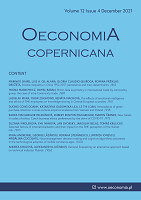How do SMEs from different countries perceive export impediments depending on their firm-level characteristics? System approach
How do SMEs from different countries perceive export impediments depending on their firm-level characteristics? System approach
Author(s): Mehmet Civelek, Vladimír KrajčíkSubject(s): Business Economy / Management, International relations/trade
Published by: Instytut Badań Gospodarczych
Keywords: SMEs; export barriers; firm size-age-sector; Czech-Slovak-Hungarian SMEs; export risk;
Summary/Abstract: Research background: The differences in the legal structures, tax rates, and cultural-linguistic issues of various countries have always been a significant concern for SMEs in their exporting activities and internationalization processes. However, since firm-level characteristics might provide some advantages or disadvantages in their operations, their perceptions of export impediments might vary across size, age, and sector groups. Purpose of the article: This paper investigates the perceptions of export impediments by 408 larger-smaller, older-younger, and manufacturing-nonmanufacturing Czech, Slovakian and Hungarian SMEs in a country-based perspective. Methods: The researchers use the random sampling method to create research samples and employ an internet-mediated questionnaire to collect the research data. The researchers use both Independent Sample T-test and ANOVA analyses to find differences between size, age, and sector groups. Findings & value added: While the differences exist between the perceptions of Slovakian larger-smaller and manufacturing-nonmanufacturing SMEs regarding cultural differences, the perceptions of legal and tax-related export impediments by SMEs do not differ depending on their age, size, and sector. This paper contributes to the literature by confirming various perceptions of SMEs in different countries and different characteristics regarding export obstacles and providing an entity-specific and international scope that policymakers and SMEs can benefit from. Awareness of the policymakers regarding the results of this paper that includes differences and similarities in SMEs? perceptions of export barriers might make them have close interactions with SMEs to reduce SMEs? concerns regarding their export risks. On the other hand, SMEs that are aware of the results of this paper can be more interested in having a broader network that includes close relationships not only with intermediary firms, but also with governments to overcome the export impediments.
Journal: Oeconomia Copernicana
- Issue Year: 13/2022
- Issue No: 1
- Page Range: 55-78
- Page Count: 24
- Language: English

